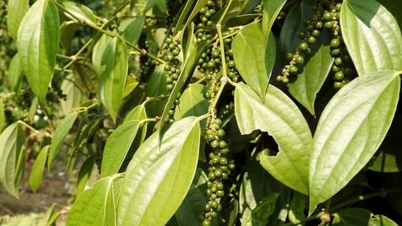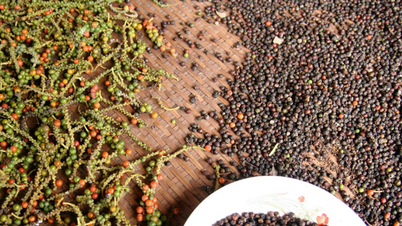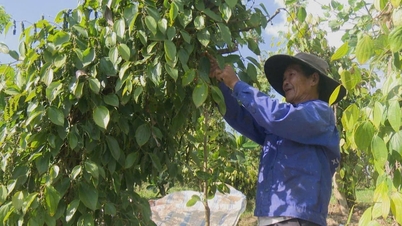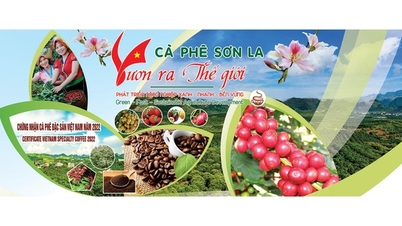Domestic pepper prices continue to decrease for the second week, many regions lose up to 1,500 VND/kg
The market on November 17 recorded domestic pepper prices fluctuating between 144,000 and 145,500 VND/kg. Weekly, the decrease was around 500 - 1,500 VND/kg, marking the second consecutive week of adjustment.
Dak Lak and Dak Nong are the two regions with the sharpest decline, down 1,500 VND/kg compared to last week, bringing the purchase price to 145,500 VND/kg. Binh Phuoc, Dong Nai and Ba Ria - Vung Tau decreased 1,000 VND/kg, commonly at 144,000 VND/kg. Gia Lai only decreased slightly, currently trading around 144,500 VND/kg.
| Market (survey area) | Purchase price on November 17 (Unit: VND/kg) | Change from last week (Unit: VND/kg) |
| Dak Lak | 145,500 | -1,500 |
| Gia Lai | 144,500 | -500 |
| Dak Nong | 145,500 | -1,500 |
| Ba Ria – Vung Tau | 144,000 | -1,000 |
| Binh Phuoc | 144,000 | -1,000 |
| Dong Nai | 144,000 | -1,000 |
Mixed world developments: Indonesia down, Brazil up
Data from IPC shows that the international market is divided. Indonesian black pepper prices decreased slightly by $3/ton to $7,108/ton. In contrast, Brazilian black pepper ASTA 570 increased by $75/ton to $6,175/ton. Malaysian black pepper remained stable at $9,200/ton.
Vietnam’s black pepper exports remained at 6,400 – 6,600 USD/ton for 500 g/l and 550 g/l, maintaining a balance compared to the region. In the white pepper group, Indonesia decreased by 4 USD/ton to 9,745 USD/ton, while Malaysia and Vietnam remained unchanged at 12,300 USD/ton and 9,050 USD/ton, respectively.

US reciprocal tax exemption for spices: great opportunity for Vietnam pepper export
On November 14, US President Donald Trump signed a decree exempting many products from tariffs such as coffee, tea, tropical fruits, juices, cocoa, bananas, beef and spices. This is considered an opening step for the Vietnamese pepper industry, as tax barriers can be reduced if the products are exempted.
The Vietnam Pepper and Spices Association believes that the opportunity to return to the US market is completely feasible if businesses meet the requirements on quality, standards and import records. However, exemption from reciprocal tax does not mean exemption from all import taxes. Businesses must still comply with normal tax rates, customs regulations, food safety testing and SPS standards.
In addition, the tax-free list does not include the entire agricultural product group, so businesses need to discuss directly with US partners to clearly understand the actual applicable terms as well as update risks regarding traceability and quarantine.
The wider impact of the new US tax policy and India's position
According to GTRI, the US exempts reciprocal tariffs on $50 billion worth of agricultural products that the country does not produce itself. India alone accounts for only $548 million of this product group. India's exports to the US focus on high-value spices such as pepper and chili preparations ($181 million), ginger-turmeric-curry powder ($84 million), star anise-fennel ($85 million), cardamom-nutmeg ($15 million), tea ($68 million) and small amounts of coconut, cocoa, cinnamon, and cloves.
India has virtually no presence in the large duty-free agricultural categories such as bananas, tomatoes, citrus fruits or juices. It is not yet clear whether India’s duty-free rate will be 25% or the full 50%.
GTRI assesses that while India may benefit to some extent, countries in Latin America, Africa and ASEAN are the groups that will benefit more due to their supply advantages.
Source: https://baodanang.vn/gia-tieu-hom-nay-17-11-2025-giam-tuan-thu-hai-3310254.html


![[Photo] Prime Minister Pham Minh Chinh meets with representatives of outstanding teachers](https://vphoto.vietnam.vn/thumb/1200x675/vietnam/resource/IMAGE/2025/11/15/1763215934276_dsc-0578-jpg.webp)




![[Photo] General Secretary To Lam receives Vice President of Luxshare-ICT Group (China)](https://vphoto.vietnam.vn/thumb/1200x675/vietnam/resource/IMAGE/2025/11/15/1763211137119_a1-bnd-7809-8939-jpg.webp)
































































































Comment (0)